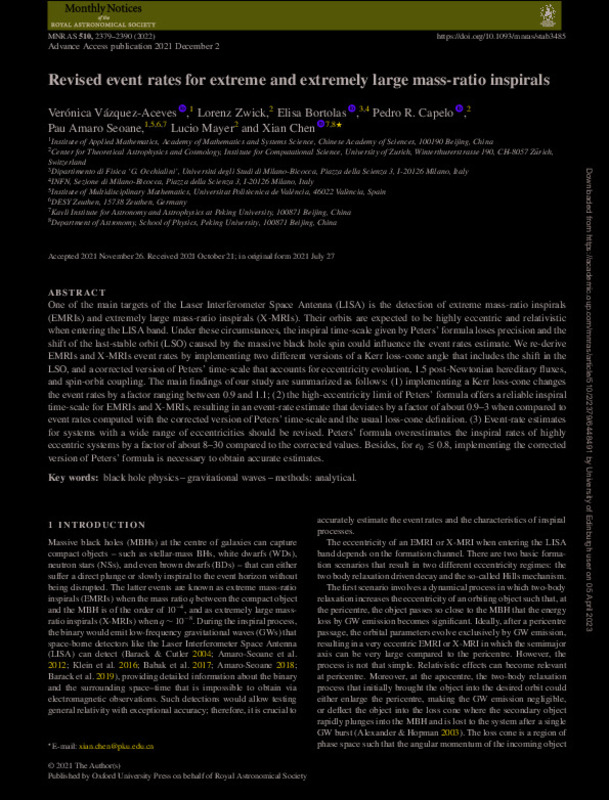JavaScript is disabled for your browser. Some features of this site may not work without it.
Buscar en RiuNet
Listar
Mi cuenta
Estadísticas
Ayuda RiuNet
Admin. UPV
Revised event rates for extreme and extremely large mass-ratio inspirals
Mostrar el registro sencillo del ítem
Ficheros en el ítem
| dc.contributor.author | Vázquez-Aceves, Verónica
|
es_ES |
| dc.contributor.author | Zwick, Lorenz
|
es_ES |
| dc.contributor.author | Bortolas, Elisa
|
es_ES |
| dc.contributor.author | Capelo, Pedro R.
|
es_ES |
| dc.contributor.author | Amaro-Seoane, Pau
|
es_ES |
| dc.contributor.author | Mayer, Lucio
|
es_ES |
| dc.contributor.author | Chen, Xian
|
es_ES |
| dc.date.accessioned | 2023-09-22T18:01:41Z | |
| dc.date.available | 2023-09-22T18:01:41Z | |
| dc.date.issued | 2022-02 | es_ES |
| dc.identifier.issn | 0035-8711 | es_ES |
| dc.identifier.uri | http://hdl.handle.net/10251/196974 | |
| dc.description.abstract | [EN] One of the main targets of the Laser Interferometer Space Antenna (LISA) is the detection of extreme mass-ratio inspirals (EMRIs) and extremely large mass-ratio inspirals (X-MRIs). Their orbits are expected to be highly eccentric and relativistic when entering the LISA band. Under these circumstances, the inspiral time-scale given by Peters' formula loses precision and the shift of the last-stable orbit (LSO) caused by the massive black hole spin could influence the event rates estimate. We re-derive EMRIs and X-MRIs event rates by implementing two different versions of a Kerr loss-cone angle that includes the shift in the LSO, and a corrected version of Peters' time-scale that accounts for eccentricity evolution, 1.5 post-Newtonian hereditary fluxes, and spin-orbit coupling. The main findings of our study are summarized as follows: (1) implementing a Kerr loss-cone changes the event rates by a factor ranging between 0.9 and 1.1; (2) the high-eccentricity limit of Peters' formula offers a reliable inspiral time-scale for EMRIs and X-MRIs, resulting in an event-rate estimate that deviates by a factor of about 0.9-3 when compared to event rates computed with the corrected version of Peters' time-scale and the usual loss-cone definition. (3) Event-rate estimates for systems with a wide range of eccentricities should be revised. Peters' formula overestimates the inspiral rates of highly eccentric systems by a factor of about 8-30 compared to the corrected values. Besides, for e(0) <= 0.8, implementing the corrected version of Peters' formula is necessary to obtain accurate estimates. | es_ES |
| dc.description.sponsorship | VVA acknowledges support from CAS-TWAS President's PhD Fellowship Programme of the Chinese Academy of Sciences & The World Academy of Sciences. PAS acknowledges support from the Ramon y Cajal Programme of the Ministry of Economy, Industry and Competitiveness of Spain, as well as the financial support of Programa Estatal de Generacion de Conocimiento (ref. PGC2018096663-B-C43) (MCIU/FEDER). This work was supported by the National Key R&D Program of China (2016YFA0400702) and the National Science Foundation of ('hina (11721303, 11873022 and 11991053). PRC, LM, and LZ acknowledge support from the Swiss National Science Foundation under the Grant 200020_178949. EB acknowledges support from the European Research Council (ERC) under the European Union's Horizon 2020 research and innovation program ERC-2018-COG under grant agreement N. 818691 (B Massive). | es_ES |
| dc.language | Inglés | es_ES |
| dc.publisher | Oxford University Press | es_ES |
| dc.relation.ispartof | Monthly Notices of the Royal Astronomical Society | es_ES |
| dc.rights | Reconocimiento (by) | es_ES |
| dc.subject | Black hole physics | es_ES |
| dc.subject | Gravitational waves | es_ES |
| dc.subject | Methods: analytical | es_ES |
| dc.subject.classification | MATEMATICA APLICADA | es_ES |
| dc.title | Revised event rates for extreme and extremely large mass-ratio inspirals | es_ES |
| dc.type | Artículo | es_ES |
| dc.identifier.doi | 10.1093/mnras/stab3485 | es_ES |
| dc.relation.projectID | info:eu-repo/grantAgreement/AEI/Plan Estatal de Investigación Científica y Técnica y de Innovación 2017-2020/PGC2018-096663-B-C43/ES/FISICA FUNDAMENTAL, DETECCION ACUSTICA Y ASTRONOMIA MULTI-MENSAJERO CON TELESCOPIOS DE NEUTRINOS EN LA UPV/ | es_ES |
| dc.relation.projectID | info:eu-repo/grantAgreement/NSFC//11991053/ | es_ES |
| dc.relation.projectID | info:eu-repo/grantAgreement/EC/H2020/818691/EU | es_ES |
| dc.relation.projectID | info:eu-repo/grantAgreement/NSFC//11721303/ | es_ES |
| dc.relation.projectID | info:eu-repo/grantAgreement/NSFC//11873022/ | es_ES |
| dc.relation.projectID | info:eu-repo/grantAgreement/NKRDPC//2016YFA0400702/ | es_ES |
| dc.relation.projectID | info:eu-repo/grantAgreement/SNSF//200020_178949/ | es_ES |
| dc.rights.accessRights | Abierto | es_ES |
| dc.contributor.affiliation | Universitat Politècnica de València. Escuela Técnica Superior de Ingeniería del Diseño - Escola Tècnica Superior d'Enginyeria del Disseny | es_ES |
| dc.description.bibliographicCitation | Vázquez-Aceves, V.; Zwick, L.; Bortolas, E.; Capelo, PR.; Amaro-Seoane, P.; Mayer, L.; Chen, X. (2022). Revised event rates for extreme and extremely large mass-ratio inspirals. Monthly Notices of the Royal Astronomical Society. 510(2):2379-2390. https://doi.org/10.1093/mnras/stab3485 | es_ES |
| dc.description.accrualMethod | S | es_ES |
| dc.relation.publisherversion | https://doi.org/10.1093/mnras/stab3485 | es_ES |
| dc.description.upvformatpinicio | 2379 | es_ES |
| dc.description.upvformatpfin | 2390 | es_ES |
| dc.type.version | info:eu-repo/semantics/publishedVersion | es_ES |
| dc.description.volume | 510 | es_ES |
| dc.description.issue | 2 | es_ES |
| dc.relation.pasarela | S\487807 | es_ES |
| dc.contributor.funder | European Commission | es_ES |
| dc.contributor.funder | Chinese Academy of Sciences | es_ES |
| dc.contributor.funder | The World Academy of Sciences | es_ES |
| dc.contributor.funder | Agencia Estatal de Investigación | es_ES |
| dc.contributor.funder | Swiss National Science Foundation | es_ES |
| dc.contributor.funder | European Regional Development Fund | es_ES |
| dc.contributor.funder | National Natural Science Foundation of China | es_ES |
| dc.contributor.funder | National Key Research and Development Program of China | es_ES |








